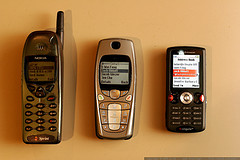You're probably saying to yourself "But Keith, what do you know about the mobile web (WAP)? Don't you just do stuff with Drupal, dotProject, etc?" Well, not quite…
 In the past couple years, the mobile web – aka web on your phone aka WAP- has actually started to become… well, useful. Don't worry, I'm as surprised as many others. If you go back and look at some of the early WML 1.0 sites, you'll get a feel for how things used to be. For instance, the entire metaphor for mobile web was based on a deck of cards. The site itself was called a "deck". And therefore, each page was called… ? You guessed it, a card! No, I'm not kidding, here is the WML 1.0 sample from Wikipedia:
In the past couple years, the mobile web – aka web on your phone aka WAP- has actually started to become… well, useful. Don't worry, I'm as surprised as many others. If you go back and look at some of the early WML 1.0 sites, you'll get a feel for how things used to be. For instance, the entire metaphor for mobile web was based on a deck of cards. The site itself was called a "deck". And therefore, each page was called… ? You guessed it, a card! No, I'm not kidding, here is the WML 1.0 sample from Wikipedia:
<?xml version="1.0"?>
<!DOCTYPE wml PUBLIC "-//PHONE.COM//DTD WML 1.1//EN"
"http://www.phone.com/dtd/wml11.dtd" >
<wml>
<card id="main" title="First Card">
<p mode="wrap">This is a sample WML page.</p>
</card>
</wml>
Strike 1.
Then there was this huge movement towards BREW (Java)-based applications. Initially, this sounded wonderful because of Java's principle of Write Once Run Anywhere. In practice, this did not work out quite as expected. There have been a plethora of devices each with their own little oddities and difficulties in addition to technical limitations like memory, storage space, etc. Pretty common issues and easily addressable on most computers but when you're working on specific version of a custom operating system o a tiny device with few resources which there are only a few hundred thousand off, the sheer complexity of testing compatibility is overwhelming.
Strike 2.
 Well, luckily, times have changed. We still call the sites "decks" but we call each individual page a "page'. In addition, for the most part, devices have respectable XHTML support. This is less due to the devices themselves but due to the manufacturers realizing that building, testing (or not), and maintaining their own custom browser was ridiculous. At this point, the sheer number of browser variations are smaller even as the number (and size) of devices increase. There are still a few oddities in rendering but the bulk of regular HTML and CSS are supported.
Well, luckily, times have changed. We still call the sites "decks" but we call each individual page a "page'. In addition, for the most part, devices have respectable XHTML support. This is less due to the devices themselves but due to the manufacturers realizing that building, testing (or not), and maintaining their own custom browser was ridiculous. At this point, the sheer number of browser variations are smaller even as the number (and size) of devices increase. There are still a few oddities in rendering but the bulk of regular HTML and CSS are supported.
But here's the thing… there are still devices shaking all of this up. Your standard mobile browser doesn't support Javascript in any useful form. Therefore, your cool Web2.0 functionality crashes and burns. But the iPhone has some rudimentary Javascript support. Normally, I wouldn't think that a single device would cause that much of a stir, but you need to consider the market demographics:
First, the people with iPhones at this point are the early adopters. Yes, they're fickle, but they are the most likely individuals using the mobile web.
Second, services like Twitter – despite my suspicions that they're carrier-controlled fronts, are growing and expanding faster than they can keep up. As individuals become less tied to their desks, we're seeing huge growth of related services. Twitter (and its clones) are where blogging was in 98/99 or so. No, I don't care about what you had for breakfast, but some people are beginning to use it in interesting ways.
Third, according to some claims, upwards of 16% of people 18-30 have given up their home phones and only have cell phones. They saw no reason to pay for a land line with long distance while using a cell phone… I did this in Dec 2003.
Finally, these users are generally smart, tech savvy, have a few dollars to burn ($600 on a phone!?) and are connected with dozens with the same profile. Therefore, when you connect with one of them, you have the potential to connect with all of their friends in a matter of moments.
So what are you doing to get mobile? How are you staying connected with these people? How are you staying relevant? Do you care?
* Disclosure: I have been working in this space since 2005 and built the Mobile.FoxNews.com site pictured above. Keep an eye on this space for an announcement…
